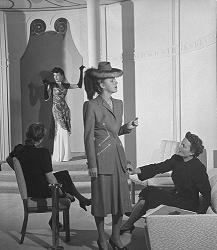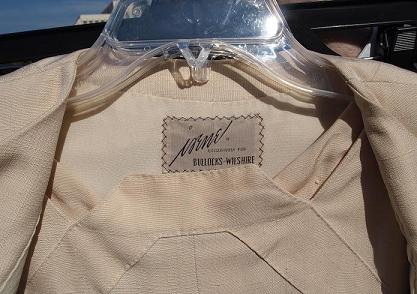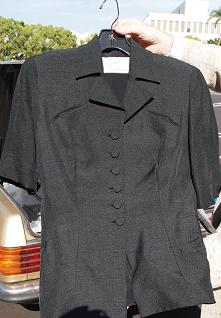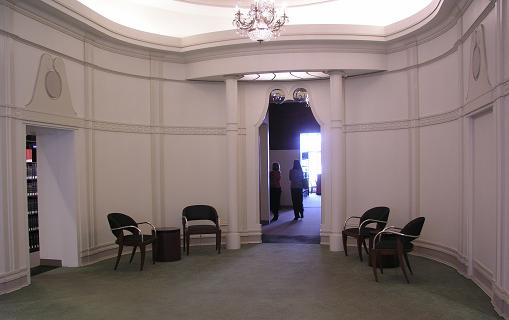Southwestern Law School

A few weeks back on a beautiful Sunday afternoon, my husband took my parents, the kids and me, on a little tour of his law School, Southwestern! We had the best time. Rich said that he was especially excited to take my mom on a tour of the historic old building known as The Bullocks Wilshire building, ( which is now the home of Southwestern Law School), because of the fond memories my mother has of shopping with her mother at the Old Bullocks Wilshire department store when she was just a little girl.


If you grew-up in Los Angeles or in one of the surrounding suburbs in the 1950's, then you might remember shopping trips to the Bullocks-Wilshire department store in Los Angeles.

My mother has such beautiful memories as a little girl of getting all dressed-up in her Sunday best with her mother and riding the bus to this gorgeous department store!
I can picture it now, I am sure my mother wore a red Pendelton coat with black shiny Mary Jane shoes and frilly little white socks. My grandmother probably wore a beautiful powder blue suit with a pillbox hat and dainty white gloves... or at lease that is how I picture it in my imagination! :)
I wish we still dressed this way, classic and timeless.

I have been told that if you wanted the latest fashions of the day, you didn't need to visit Paris or New York, you could simply head over to Bullocks-Wilshire and visit Irene.
Here is a little side story I found about a designer named Irene,
Once upon a time, there was an amazing designer who lived in Los Angeles. Her name was Irene Lentz-Gibbons. British Vogue called Irene's designs "Californian elegance." Way before New York Fashion Week, Irene held her fashion events at the beautiful art deco department store, Bullocks Wilshire. She also designed fashions for the store and privately labeled them. From 1935 to the mid 1940s, American designer Irene Lentz-Gibbons had her own salon in the midst of this retail Utopia. You didn't need to go to Paris or New York to get the latest fashions, you could simply head to Bullocks-Wilshire and visit Irene. 


Irene left Bullocks-Wilshire to become executive designer for Metro-Goldwyn-Mayer Studios. She designed costumes for over fifty films. Later, she sold an "Irene" line at New York's Bergdorf Goodman, Chicago's Marshall Field and Dallas' Neiman-Marcus. Eventually, those lines perished as did the Bullocks-Wilshire store. The store closed in 1992. Today, the Irene salon still lives on as part of the Southwestern Law School. When I took the tour of Bullocks- Wilshire, sponsored by the law school this week, I was pleased to see the Irene salon almost exactly as the designer had left it. Her sketches were hanging on the walls along with a few plaques commemorating her designs. You can almost hear the footsteps of a frequent visitor to Bullocks, Gary Cooper, bounding up the stairs into the salon to visit his special friend, Hollywood's hottest designer, Irene Lentz.

Today, Irene's fashions still play a part in Hollywood productions. Her suits are worn by Kyra Sedgewick on TNT's The Closer. Costume designer Greg LaVoi uses many of Irene's designs on the show from Bullocks Wilshire. When Irene died in 1962, she may have felt that Hollywood had forgotten her. Her old friend Doris Day bought her back to work to design the costumes for the film Midnight Lace. For that film, she was nominated for an Oscar. But it was the first film she had worked on in 10 years. How pleased I think she would be to see Southwestern Law School preserving her salon and The Closer's Brenda wearing her beautiful suits. Style never dies. Especially when it has an Irene label on it.
Here is a brief history on Bullocks Wilshire ...
History of Bullocks Wilshire
It was conceived by business partners John G. Bullock and P.G. Winnett to house the upscale Bullocks Wilshire Department Store. But while the building’s function was an ordinary one, its creators had grand ambitions for its design. After visiting the 1925 Exposition of Decorative and Modern Arts in Paris, where the art deco, or "moderne," style was introduced, Winnett and architect Donald Parkinson agreed to use this new aesthetic as the inspiration for the department store. When it opened in 1929, the building was one of the first Art Deco structures built in the United States.
Parkinson - who, along with his son John, went on to design some of Los Angeles' leading landmarks, including Union Station and City Hall - created an elegant five-story structure that, even today, stands out in the skyline. The gleaming edifice was constructed with terra cotta-clad reinforced concrete and accented with green verdigris copper. While building codes at the time sought to cap structures at 150 feet, the architects found a loophole enabling them to erect the Bullocks Wilshire building at 241 feet.
Like the German Bauhaus School of Design, Art Deco combines function and beauty, and embraces contrasts among geometric shapes, vibrant colors, and exotic materials. Abstractions from nature combine with forms common to machinery. Most of all, Art Deco celebrates the modern age. In the 1920's mass production techniques, technology, and new modes of travel were rapidly changing the way people lived, and they influenced Art Deco design. This celebration of the modern age greets visitors arriving at the Bullocks Wilshire entrance where one can admire the magnificent dry fresco, The Spirit of Transportation. Painted by Herman Sachs, the Spirit of Transportation celebrates all modes of transportation common to the era except the car: flight, rail, ocean liner, and the great dirigibles.

The Tea Room - 1929
For more than 60 years, the name Bullocks Wilshire was synonymous with elegance and style. However, over the years, many of the building's prized architectural features were covered or removed. In 1969, local officials recognized the structure’s unique place in architectural and civic history by naming it a Los Angeles Historic Cultural Monument. Nine years later, it took its place on the National Register of Historic Places.

Photo courtesy The Los Angeles Public Library Photo Collection

Photo courtesy The Los Angeles Public Library Photo Collection
Once a lady or gentleman stepped into the store, they were greeted with an elegance and simplicity rarely seen on the West Coast. The layout was closed, with each department its own little boutique. Live models swayed around the Louis XIV salon in designer dresses, high rolling Hollywood players smoked cigars while being presented with shirts in Jo Bullock's wood-paneled private suite, and harried mothers could drop off their children in the crib-filled nursery before peeking into a room devoted solely to the creations of Coco Chanel, or indulging in a spritz of a new fragrance in the mirrored "Hall of Perfume."

A tea room menu cover, courtesy The Los Angeles Public Library Photo Collection
A Miss Larson oversaw the tea room, and made sure it lived up to the "Bullock's ideal" of excellence in service and presentation. The menu was light and refreshing, perfect for active shoppers and a welcome respite from heavy mid-century food. It featured such tea-time fare as finger sandwiches, pecan rolls, an assortment of fresh bread, including orange, date and nut, and cheese, and its famous Cantonese chicken salad with strawberry dressing. For dessert, fluffy coconut cream pie was a specialty, as was French chocolate layer cake, and a cream cheese ring with assorted fruit.
For the numerous figure-conscious Hollywood stars who frequented the tea room, including Gloria Swanson, Norma Shearer, Clarke Gable, Carole Lombard and John Wayne, there was also a "streamline menu." A veggie platter consisted of grilled tomatoes, mushrooms, string beans, asparagus, squash and celery. On Tuesdays, for only $1.25, there was a fashion luncheon where ladies could nibble all these healthful goodies while viewing models wearing the latest fashions.

Photo courtesy The Los Angeles Public Library Photo Collection
Unlike many of these L.A. stories of faded glamour, Bullock's Wilshire has had a surprisingly satisfying second act. It was bought by Southwestern Law School, which has been careful and diligent in its preservation efforts. The tea room is now used as a study hall, can be rented for private events and is opened to the public on the school's annual tea and tour day, which takes place during summer break. And the famed coconut cream pie still exists --
I think I will most definitely have to track down the recipe of this famous Coconut Cream Pie!!!
Business Declines, Southwestern Steps In
Eventually, business at Bullocks Wilshire took a downfall, as malls moved into suburbia, shopping habits and merchandising changed, and high-end stores opened farther west. In the 1980s, after a dispute among its directors, the store was sold to Federated Department Stores. Macy's later purchased the business, but in 1993 the company filed for bankruptcy. The store was closed permanently, marking the end of an era and generating serious concern for the future of one of the city's most beautiful and beloved buildings.

Rebirth of a Treasure
Over the next ten years, Southwestern meticulously restored the Bullocks Wilshire building to its original luster and design. Drawing from original plans, archival photos, and other historic documents, the law school refurbished or reproduced the property's distinctive colors, decor and other details, while adapting the building to serve as a dynamic academic facility.


Southwestern has received numerous awards for its sensitive restoration and adaptive reuse of the structure, including the 2005 President's Award from the Los Angeles Conservancy, 2000 National Preservation Award from the National Trust for Historic Preservation and the Governor's Historic Preservation Award from the California Office of Historic Preservation.
Today, the Bullocks Wilshire is the heart of the Southwestern campus - a shining example of the school’s thoughtful and determined effort to raise the bar for legal education.
A few photos from our day at Southwestern Law School ...


Above is a photo of my two guys! Robbie is so proud of his Daddy!

My twinies!

Gigi

Gigi and Robbie waiting to our the school on the cool old elevators.

The view of Downtown LA from the historic Tea Room.

Below is a small photo of a study area at the school's library.

The long hallway previously the perfume room at Bullocks Wilshire.

Even the bathroom/ powder room was beautiful!

I think Robbie's favorite part of the whole day was visiting the vending machines and crawling on this cool retro couch at the school.



Huell Howser from California's Gold did an entire show on Southwestern Law School/ The Bullocks Willshire building.You can get more information here. http://www.calgold.com/visiting/Default.asp?Series=100&Show=141
We had a great day!
No comments:
Post a Comment